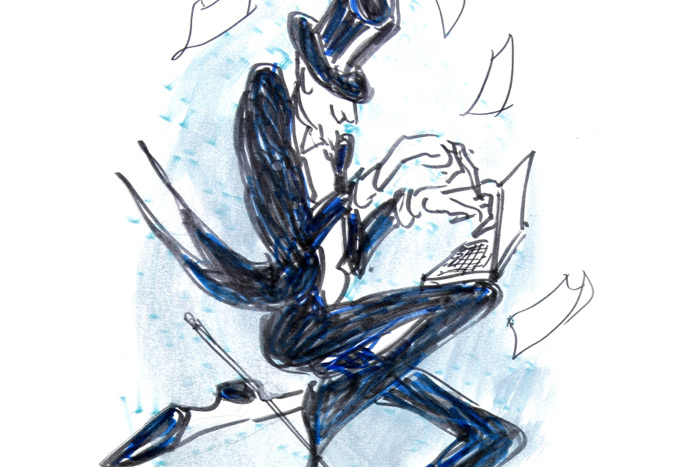A Talk with Dan's Papers Cover Artist Jules Feiffer

In Out of Line: The Art of Jules Feiffer, by Martha Fay, the recently published retrospective about the much–honored, subversive, Pulitzer Prize–winning American cartoonist for grown-ups, the iconic playwright, screenwriter, producer, children’s book author, graphic novelist, satirist, educator and generous human being Feiffer is quoted as saying “The one thing I should have been I’m not: Fred Astaire,” because “I didn’t have the talent or discipline.”
But, he adds, he did the “next best thing,” which was to “tap dance my way through life…tap dancing through relationships, family, in and out of personal crises.”
But Feiffer could well be called the Fred Astaire of cartooning, the master of the elegant, gestural line, of angular figures in motion, of sophisticated, witty caricatures of individuals and types rendered with a seeming nonchalance and minimalist touch. A man with a sensibility and execution that are immediately and incomparably distinctive.
This prolific and varied artist never does the same drawing exactly the same way, and as this week’s cover art shows, he keeps up-to-date. Here’s Astaire paused slightly in dance, walking stick on his feet, happily knocking out a few pages on a laptop. In time for the Dan’s Papers Literary Prize for Nonfiction Awards Ceremony on Saturday, August 29, the picture is a reminder that Feiffer started his 70-plus year career as a writer filling panels with words on life’s absurdities, delusions and hypocrisies.

You’ve been called “an American original.” Now going strong at the ripe and wise age of 86, would you still concur with the evaluation of you as “the ultimate anti-organization man?”
I don’t like labels, but it was clear to me from the beginning and it’s no less clear now as I near the end that The System as we know it and as it over-organizes itself is not the way I can function. I tried early on but I was a dismal failure at it. The organizations may change but the rule makers don’t. They are the same people in the same positions who say, “It’s my way or the highway.” So I took the highway.
Kill My Mother, which came out last year, was your first graphic novel. What was the prompt to go in this extended narrative direction?
In some ways doing a graphic novel was an adjustment to old age. I couldn’t keep working in the theater, where you’re supposed to hear what’s going on. And walking wasn’t that easy anymore. So I got the hell out and became a fulltime Hamptons resident. And now I can recreate the illusion that I can do it all when I sit down at my drawing table, which I couldn’t do in the city. If I couldn’t do plays on paper I could write graphic novels, close enough, and as much or even more fun. I can direct all the characters. I just turned in Vol. II of Kill My Mother, which was set in 1933. Vol. II is actually a prequel called Cousin Joseph and is set in 1931. There will be a Book III, Archie Goldman, set in the 1950s, during the Hollywood black list period and that will complete the cycle.
Have the targets of satiric cartoonists changed over the years, and is there new danger in light of the attacks on Charlie Hebdo?
Charlie Hebdo was not a terrorist attack that should particularly affect Americans because for American cartoonists the terrorists have always been and continue to be editors and publishers who often express an aversion to anything graphic, especially physical violence. The violence that should really concern writers and artists is economic violence.
Jules Feiffer will award the Dan’s Papers Literary Prize for Nonfiction Emerging Writers Award on August 29 at Guild Hall.




